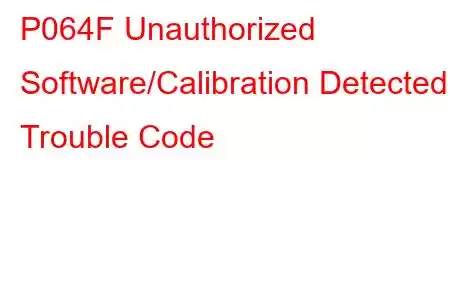P064F Unauthorized Software/Calibration Detected
OBD-II Trouble Code Technical Description
Unauthorized Software/Calibration Detected
What does that mean?
This is a generic diagnostic trouble code (DTC) and applies to many OBD-II vehicles (1996-newer). That may include but is not limited to vehicles from Acura, Audi, Buick, Cadillac, Chevrolet, Chrysler, Ford, Hyundai, Jaguar, Kia, Nissan, Scion, Toyota, etc. Although generic, the exact repair steps may vary depending on year, make, model, and powertrain configuration.
A stored code P064F means that the powertrain control module (PCM) has detected an unauthorized or unrecognized software application or a controller calibration error.
The installation of factory software and calibration of on-board controllers is frequently referred to as programming. While most programming is performed before the vehicle is delivered to the owner, on-board controllers continue to adapt to specific circumstances and effectively learn in order to meet the needs of individual drivers and geographic locations (among other things). Factors that include voltage spikes, excessive temperatures, and excessive moisture may contribute to software and calibration failure.
Installing aftermarket software programs may lead to a code P064F being stored but it is usually temporary. Once the PCM learns the software, and the code is cleared, it will usually not be reset.
Each time the ignition is turned on and the PCM is energized, multiple controller self-tests are performed. By performing controller self-tests, the PCM can monitor serial data that is carried over the controller area network (CAN) to ensure that on-board controllers are interfacing properly. Memory functions, along with software applications, are tested at this time and also tested periodically when the ignition is in the ON position.
If a problem is detected in monitoring controller software/calibration, a code P064F will be stored and a malfunction indicator lamp (MIL) may be illuminated.
A typical PCM powertrain control module, opened up:
What is the severity of this DTC?
A P064F should be treated as severe because it could result in various engine starting and/or drivability problems.
What are some of the symptoms of the code?
Symptoms of a P064F trouble code may include:
Delayed or no engine start-up Engine drivability issues Other stored codesWhat are some of the common causes of the code?
Causes for this code may include:
PCM programming error Faulty controller or PCM Installation of aftermarket or high performance softwareWhat are some P064F troubleshooting steps?
Even for the most experienced and well equipped technician, a code P064F can be particularly challenging to diagnose. Without access to reprogramming equipment, an accurate diagnosis will be virtually impossible.
Consult your vehicle information source for technical service bulletins (TSB) that replicate the code stored, vehicle (year, make, model, and engine), and symptoms exhibited. If you find the appropriate TSB, it may yield helpful diagnostic information.
Begin by connecting the scanner to the vehicle diagnostic port and retrieving all stored codes and freeze frame data. You will want to write this information down, just in case the code proves to be an intermittent one.
After recording all pertinent information, clear the codes and test drive the vehicle (if possible) until the code is reset or the PCM enters readiness mode.
If the PCM enters readiness mode, the code is intermittent and will be even more difficult to diagnose. The condition, which caused the P064F to be stored, may need to worsen before an accurate diagnosis can be reached. On the other hand, if the code fails to reset and there are no drivability symptoms exhibited, the vehicle can be operated normally.
Test controller ground integrity by connecting the negative test lead of the DVOM to ground and the positive test lead to battery voltageRead: 44


